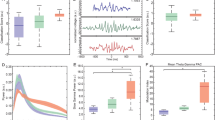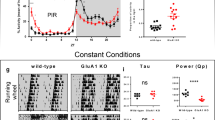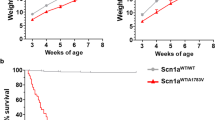Abstract
High-affinity nicotinic receptors containing β2 subunits (β2*) are widely expressed in the brain, modulating many neuronal processes and contributing to neuropathologies such as Alzheimer's disease, Parkinson's disease and epilepsy. Mutations in both the α4 and β2 subunits are associated with a rare partial epilepsy, autosomal dominant nocturnal frontal lobe epilepsy (ADNFLE). In this study, we introduced one such human missense mutation into the mouse genome to generate a knock-in strain carrying a valine-to-leucine mutation β2V287L. β2V287L mice were viable and born at an expected Mendelian ratio. Surprisingly, mice did not show an overt seizure phenotype; however, homozygous mice did show significant alterations in their activity–rest patterns. This was manifest as an increase in activity during the light cycle suggestive of disturbances in the normal sleep patterns of mice; a parallel phenotype to that found in human ADNFLE patients. Consistent with the role of nicotinic receptors in reward pathways, we found that β2V287L mice did not develop a normal proclivity to voluntary wheel running, a model for natural reward. Anxiety-related behaviors were also affected by the V287L mutation. Mutant mice spent more time in the open arms on the elevated plus maze suggesting that they had reduced levels of anxiety. Together, these findings emphasize several important roles of β2* nicotinic receptors in complex biological processes including the activity–rest cycle, natural reward and anxiety.
This is a preview of subscription content, access via your institution
Access options
Subscribe to this journal
Receive 12 print issues and online access
$259.00 per year
only $21.58 per issue
Buy this article
- Purchase on Springer Link
- Instant access to full article PDF
Prices may be subject to local taxes which are calculated during checkout





Similar content being viewed by others
References
Karlin A, Akabas MH . Toward a structural basis for the function of nicotinic acetylcholine receptors and their cousins. Neuron 1995; 15: 1231–1244.
McGehee DS, Role LW . Physiological diversity of nicotinic acetylcholine receptors expressed by vertebrate neurons. Annu Rev Physiol 1995; 57: 521–546.
Sargent PB . The diversity of neuronal nicotinic acetylcholine receptors. Annu Rev Neurosci 1993; 16: 403–443.
Whiting P, Lindstrom J . Purification and characterization of a nicotinic acetylcholine receptor from rat brain. Proc Natl Acad Sci USA 1987; 84: 595–599.
Wada E, Wada K, Boulter J, Deneris E, Heinemann S, Patrick J et al. Distribution of alpha 2, alpha 3, alpha 4, and beta 2 neuronal nicotinic receptor subunit mRNAs in the central nervous system: a hybridization histochemical study in the rat. J Comp Neurol 1989; 284: 314–335.
Zoli M, Lena C, Picciotto MR, Changeux JP . Identification of four classes of brain nicotinic receptors using beta2 mutant mice. J Neurosci 1998; 18: 4461–4472.
Dani JA, Bertrand D . Nicotinic acetylcholine receptors and nicotinic cholinergic mechanisms of the central nervous system. Annu Rev Pharmacol Toxicol 2007; 47: 699–729.
Picciotto MR, Zoli M, Lena C, Bessis A, Lallemand Y, Le Novere N et al. Abnormal avoidance learning in mice lacking functional high-affinity nicotine receptor in the brain. Nature 1995; 374: 65–67.
Picciotto MR, Zoli M, Rimondini R, Lena C, Marubio LM, Pich EM et al. Acetylcholine receptors containing the beta2 subunit are involved in the reinforcing properties of nicotine. Nature 1998; 391: 173–177.
Avale ME, Faure P, Pons S, Robledo P, Deltheil T, David DJ et al. Interplay of beta2* nicotinic receptors and dopamine pathways in the control of spontaneous locomotion. Proc Natl Acad Sci USA 2008; 105: 15991–15996.
Granon S, Faure P, Changeux JP . Executive and social behaviors under nicotinic receptor regulation. Proc Natl Acad Sci USA 2003; 100: 9596–9601.
Maubourguet N, Lesne A, Changeux JP, Maskos U, Faure P . Behavioral sequence analysis reveals a novel role for beta2* nicotinic receptors in exploration. PLoS Comput Biol 2008; 4: e1000229.
Cohen G, Han ZY, Grailhe R, Gallego J, Gaultier C, Changeux JP et al. Beta 2 nicotinic acetylcholine receptor subunit modulates protective responses to stress: a receptor basis for sleep-disordered breathing after nicotine exposure. Proc Natl Acad Sci USA 2002; 99: 13272–13277.
Lena C, Popa D, Grailhe R, Escourrou P, Changeux JP, Adrien J . Beta2-containing nicotinic receptors contribute to the organization of sleep and regulate putative micro-arousals in mice. J Neurosci 2004; 24: 5711–5718.
De Fusco M, Becchetti A, Patrignani A, Annesi G, Gambardella A, Quattrone A et al. The nicotinic receptor beta 2 subunit is mutant in nocturnal frontal lobe epilepsy. Nat Genet 2000; 26: 275–276.
Bertrand D, Picard F, Le Hellard S, Weiland S, Favre I, Phillips H et al. How mutations in the nAChRs can cause ADNFLE epilepsy. Epilepsia 2002; 43 (Suppl 5): 112–122.
Fonck C, Cohen BN, Nashmi R, Whiteaker P, Wagenaar DA, Rodrigues-Pinguet N et al. Novel seizure phenotype and sleep disruptions in knock-in mice with hypersensitive alpha 4* nicotinic receptors. J Neurosci 2005; 25: 11396–11411.
Son CD, Moss FJ, Cohen BN, Lester HA . Nicotine normalizes intracellular subunit stoichiometry of nicotinic receptors carrying mutations linked to autosomal dominant nocturnal frontal lobe epilepsy. Mol Pharmacol 2009; 75: 1137–1148.
Nagy A, Rossant J, Nagy R, Abramow-Newerly W, Roder JC . Derivation of completely cell culture-derived mice from early-passage embryonic stem cells. Proc Natl Acad Sci USA 1993; 90: 8424–8428.
O'Gorman S, Dagenais NA, Qian M, Marchuk Y . Protamine-Cre recombinase transgenes efficiently recombine target sequences in the male germ line of mice, but not in embryonic stem cells. Proc Natl Acad Sci USA 1997; 94: 14602–14607.
Dobelis P, Hutton S, Lu Y, Collins AC . GABAergic systems modulate nicotinic receptor-mediated seizures in mice. J Pharmacol Exp Ther 2003; 306: 1159–1166.
Fonck C, Nashmi R, Deshpande P, Damaj MI, Marks MJ, Riedel A et al. Increased sensitivity to agonist-induced seizures, straub tail, and hippocampal theta rhythm in knock-in mice carrying hypersensitive alpha 4 nicotinic receptors. J Neurosci 2003; 23: 2582–2590.
Xu J, Zhu Y, Contractor A, Heinemann SF . mGluR5 has a critical role in inhibitory learning. J Neurosci 2009; 29: 3676–3684.
Annegers JF, Coan SP . SUDEP: overview of definitions and review of incidence data. Seizure 1999; 8: 347–352.
Shao XM, Tan W, Xiu J, Puskar N, Fonck C, Lester HA et al. Alpha4* nicotinic receptors in preBotzinger complex mediate cholinergic/nicotinic modulation of respiratory rhythm. J Neurosci 2008; 28: 519–528.
Marini C, Guerrini R . The role of the nicotinic acetylcholine receptors in sleep-related epilepsy. Biochem Pharmacol 2007; 74: 1308–1314.
Vignatelli L, Bisulli F, Naldi I, Ferioli S, Pittau F, Provini F et al. Excessive daytime sleepiness and subjective sleep quality in patients with nocturnal frontal lobe epilepsy: a case-control study. Epilepsia 2006; 47 (Suppl 5): 73–77.
Zucconi M, Oldani A, Smirne S, Ferini-Strambi L . The macrostructure and microstructure of sleep in patients with autosomal dominant nocturnal frontal lobe epilepsy. J Clin Neurophysiol 2000; 17: 77–86.
Werme M, Messer C, Olson L, Gilden L, Thoren P, Nestler EJ et al. Delta FosB regulates wheel running. J Neurosci 2002; 22: 8133–8138.
Iversen IH . Techniques for establishing schedules with wheel running as reinforcement in rats. J Exp Anal Behav 1993; 60: 219–238.
Fowler CD, Arends MA, Kenny PJ . Subtypes of nicotinic acetylcholine receptors in nicotine reward, dependence, and withdrawal: evidence from genetically modified mice. Behav Pharmacol 2008; 19: 461–484.
Booker TK, Butt CM, Wehner JM, Heinemann SF, Collins AC . Decreased anxiety-like behavior in beta3 nicotinic receptor subunit knockout mice. Pharmacol Biochem Behav 2007; 87: 146–157.
Salas R, Pieri F, Fung B, Dani JA, De Biasi M . Altered anxiety-related responses in mutant mice lacking the beta4 subunit of the nicotinic receptor. J Neurosci 2003; 23: 6255–6263.
Picciotto MR, Brunzell DH, Caldarone BJ . Effect of nicotine and nicotinic receptors on anxiety and depression. Neuroreport 2002; 13: 1097–1106.
Damaj MI, Glassco W, Dukat M, Martin BR . Pharmacological characterization of nicotine-induced seizures in mice. J Pharmacol Exp Ther 1999; 291: 1284–1291.
Miner LL, Collins AC . Strain comparison of nicotine-induced seizure sensitivity and nicotinic receptors. Pharmacol Biochem Behav 1989; 33: 469–475.
Teper Y, Whyte D, Cahir E, Lester HA, Grady SR, Marks MJ et al. Nicotine-induced dystonic arousal complex in a mouse line harboring a human autosomal-dominant nocturnal frontal lobe epilepsy mutation. J Neurosci 2007; 27: 10128–10142.
Klaassen A, Glykys J, Maguire J, Labarca C, Mody I, Boulter J . Seizures and enhanced cortical GABAergic inhibition in two mouse models of human autosomal dominant nocturnal frontal lobe epilepsy. Proc Natl Acad Sci USA 2006; 103: 19152–19157.
Keil W, Kluge A . Über die anwendung des mäuseschwanzphänomens zur auswertung von morphin- und skopolaminpräparaten. Naunyn Schmiedebers Arch Pharmakol 1934; 174: 493–501.
Steinlein OK, Mulley JC, Propping P, Wallace RH, Phillips HA, Sutherland GR et al. A missense mutation in the neuronal nicotinic acetylcholine receptor alpha 4 subunit is associated with autosomal dominant nocturnal frontal lobe epilepsy. Nat Genet 1995; 11: 201–203.
Hirose S, Iwata H, Akiyoshi H, Kobayashi K, Ito M, Wada K et al. A novel mutation of CHRNA4 responsible for autosomal dominant nocturnal frontal lobe epilepsy. Neurology 1999; 53: 1749–1753.
Diaz-Otero F, Quesada M, Morales-Corraliza J, Martinez-Parra C, Gomez-Garre P, Serratosa JM . Autosomal dominant nocturnal frontal lobe epilepsy with a mutation in the CHRNB2 gene. Epilepsia 2008; 49: 516–520.
Phillips HA, Favre I, Kirkpatrick M, Zuberi SM, Goudie D, Heron SE et al. CHRNB2 is the second acetylcholine receptor subunit associated with autosomal dominant nocturnal frontal lobe epilepsy. Am J Hum Genet 2001; 68: 225–231.
Manfredi I, Zani AD, Rampoldi L, Pegorini S, Bernascone I, Moretti M et al. Expression of mutant beta2 nicotinic receptors during development is crucial for epileptogenesis. Hum Mol Genet 2009; 18: 1075–1088.
Leniger T, Kananura C, Hufnagel A, Bertrand S, Bertrand D, Steinlein OK . A new Chrna4 mutation with low penetrance in nocturnal frontal lobe epilepsy. Epilepsia 2003; 44: 981–985.
McLellan A, Phillips HA, Rittey C, Kirkpatrick M, Mulley JC, Goudie D et al. Phenotypic comparison of two Scottish families with mutations in different genes causing autosomal dominant nocturnal frontal lobe epilepsy. Epilepsia 2003; 44: 613–617.
Cho YW, Motamedi GK, Laufenberg I, Sohn SI, Lim JG, Lee H et al. A Korean kindred with autosomal dominant nocturnal frontal lobe epilepsy and mental retardation. Arch Neurol 2003; 60: 1625–1632.
Magnusson A, Stordal E, Brodtkorb E, Steinlein O . Schizophrenia, psychotic illness and other psychiatric symptoms in families with autosomal dominant nocturnal frontal lobe epilepsy caused by different mutations. Psychiatr Genet 2003; 13: 91–95.
Derry CP, Heron SE, Phillips F, Howell S, MacMahon J, Phillips HA et al. Severe autosomal dominant nocturnal frontal lobe epilepsy associated with psychiatric disorders and intellectual disability. Epilepsia 2008; 49: 2125–2129.
Combi R, Dalpra L, Tenchini ML, Ferini-Strambi L . Autosomal dominant nocturnal frontal lobe epilepsy--a critical overview. J Neurol 2004; 251: 923–934.
Oldani A, Zucconi M, Asselta R, Modugno M, Bonati MT, Dalpra L et al. Autosomal dominant nocturnal frontal lobe epilepsy. A video-polysomnographic and genetic appraisal of 40 patients and delineation of the epileptic syndrome. Brain 1998; 121 (Part 2): 205–223.
Ryvlin P, Rheims S, Risse G . Nocturnal frontal lobe epilepsy. Epilepsia 2006; 47 (Suppl 2): 83–86.
Panda S, Antoch MP, Miller BH, Su AI, Schook AB, Straume M et al. Coordinated transcription of key pathways in the mouse by the circadian clock. Cell 2002; 109: 307–320.
O'Hara BF, Edgar DM, Cao VH, Wiler SW, Heller HC, Kilduff TS et al. Nicotine and nicotinic receptors in the circadian system. Psychoneuroendocrinology 1998; 23: 161–173.
Miller JD, Murakami DM, Fuller CA . The response of suprachiasmatic neurons of the rat hypothalamus to photic and nicotinic stimuli. J Neurosci 1987; 7: 978–986.
Marrosu F, Portas C, Mascia MS, Casu MA, Fa M, Giagheddu M et al. Microdialysis measurement of cortical and hippocampal acetylcholine release during sleep-wake cycle in freely moving cats. Brain Res 1995; 671: 329–332.
Saint-Mleux B, Eggermann E, Bisetti A, Bayer L, Machard D, Jones BE et al. Nicotinic enhancement of the noradrenergic inhibition of sleep-promoting neurons in the ventrolateral preoptic area. J Neurosci 2004; 24: 63–67.
Maskos U, Molles BE, Pons S, Besson M, Guiard BP, Guilloux JP et al. Nicotine reinforcement and cognition restored by targeted expression of nicotinic receptors. Nature 2005; 436: 103–107.
Kelley AE, Berridge KC . The neuroscience of natural rewards: relevance to addictive drugs. J Neurosci 2002; 22: 3306–3311.
Salminen O, Murphy KL, McIntosh JM, Drago J, Marks MJ, Collins AC et al. Subunit composition and pharmacology of two classes of striatal presynaptic nicotinic acetylcholine receptors mediating dopamine release in mice. Mol Pharmacol 2004; 65: 1526–1535.
Mansvelder HD, Keath JR, McGehee DS . Synaptic mechanisms underlie nicotine-induced excitability of brain reward areas. Neuron 2002; 33: 905–919.
Zhou FM, Liang Y, Dani JA . Endogenous nicotinic cholinergic activity regulates dopamine release in the striatum. Nat Neurosci 2001; 4: 1224–1229.
Cui C, Booker TK, Allen RS, Grady SR, Whiteaker P, Marks MJ et al. The beta3 nicotinic receptor subunit: a component of alpha-conotoxin Mll-binding nicotinic acetylcholine receptors that modulate dopamine release and related behaviors. J Neurosci 2003; 23: 11045–11053.
Ross SA, Wong JY, Clifford JJ, Kinsella A, Massalas JS, Horne MK et al. Phenotypic characterization of an alpha 4 neuronal nicotinic acetylcholine receptor subunit knock-out mouse. J Neurosci 2000; 20: 6431–6441.
Labarca C, Schwarz J, Deshpande P, Schwarz S, Nowak MW, Fonck C et al. Point mutant mice with hypersensitive alpha 4 nicotinic receptors show dopaminergic deficits and increased anxiety. Proc Natl Acad Sci USA 2001; 98: 2786–2791.
Brioni JD, O'Neill AB, Kim DJ, Decker MW . Nicotinic receptor agonists exhibit anxiolytic-like effects on the elevated plus-maze test. Eur J Pharmacol 1993; 238: 1–8.
Caldarone BJ, King SL, Picciotto MR . Sex differences in anxiety-like behavior and locomotor activity following chronic nicotine exposure in mice. Neurosci Lett 2008; 439: 187–191.
Belzung C, Le Pape G . Comparison of different behavioral test situations used in psychopharmacology for measurement of anxiety. Physiol Behav 1994; 56: 623–628.
West RJ, Jarvis MJ . Effects of nicotine on finger tapping rate in non-smokers. Pharmacol Biochem Behav 1986; 25: 727–731.
Marks MJ, Burch JB, Collins AC . Genetics of nicotine response in four inbred strains of mice. J Pharmacol Exp Ther 1983; 226: 291–302.
Marubio LM, Paylor R . Impaired passive avoidance learning in mice lacking central neuronal nicotinic acetylcholine receptors. Neuroscience 2004; 129: 575–582.
Drenan RM, Grady SR, Whiteaker P, McClure-Begley T, McKinney S, Miwa JM et al. In vivo activation of midbrain dopamine neurons via sensitized, high-affinity alpha 6 nicotinic acetylcholine receptors. Neuron 2008; 60: 123–136.
Schildein S, Huston JP, Schwarting RK . Open field habituation learning is improved by nicotine and attenuated by mecamylamine administered posttrial into the nucleus accumbens. Neurobiol Learn Mem 2002; 77: 277–290.
Conners CK, Levin ED, Sparrow E, Hinton SC, Erhardt D, Meck WH et al. Nicotine and attention in adult attention deficit hyperactivity disorder (ADHD). Psychopharmacol Bull 1996; 32: 67–73.
Levin ED, Conners CK, Sparrow E, Hinton SC, Erhardt D, Meck WH et al. Nicotine effects on adults with attention-deficit/hyperactivity disorder. Psychopharmacology (Berl) 1996; 123: 55–63.
Acknowledgements
This work was supported by grants from NIH/NIDA (R01DA018247 to SFH, 5R01DA017279 to HAL), NIH/NEI (EY016807 to SP), NIH/NINDS (R01NS058894 to AC), NIH training awards (5T32NS041234-09 to JX, and 5T32EY007128-13 to YZ), and NS-011756 and NS-046464 to HAL. We thank Drs Michael Marks, Sharon Grady and Allan Collins for their suggestions.
Author information
Authors and Affiliations
Corresponding author
Additional information
Supplementary Information accompanies the paper on the Molecular Psychiatry website
Supplementary information
Rights and permissions
About this article
Cite this article
Xu, J., Cohen, B., Zhu, Y. et al. Altered activity–rest patterns in mice with a human autosomal-dominant nocturnal frontal lobe epilepsy mutation in the β2 nicotinic receptor. Mol Psychiatry 16, 1048–1061 (2011). https://doi.org/10.1038/mp.2010.78
Received:
Revised:
Accepted:
Published:
Issue Date:
DOI: https://doi.org/10.1038/mp.2010.78
Keywords
This article is cited by
-
Nocturnal Frontal Lobe Epilepsy
Current Neurology and Neuroscience Reports (2014)



